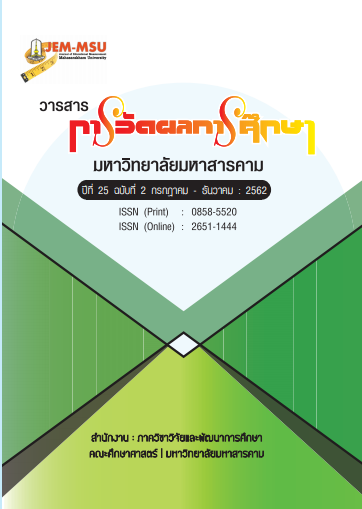The Needs Assessment for Working with the Standard of Mathematics Teachers in Basic Education Schools
Main Article Content
Abstract
The purposes of this research were to study the condition and assess the needs of teachers' organizing for learning according to the mathematics teacher standards. The sample consisted of 388 grade 10 mathematics teachers of the basic education level, from the population of 1,527 in the Northeast, obtained through multi-stage random sampling. The research employed the evaluation research methodology. The tools used in the research consisted of (1) a needs assessment form which was used for studying details of the actual practical level and the expected level of the mathematics teachers’ learning organizing; with a 5-point rating scale questionnaire containing 50 items using dual-response form, having the discrimination ranging from 0.51 to 0.83 and the Cronbach’s Alpha Coefficient of 0.95; (2) an interview form, (3) a record format for group discussion, and (4) a field record form. The analysis of data employed descriptive statistics, t-test independent was also used, and the analysis of the needs employed the modified priority needs index (PNImodified) technique.
The results of the research were as follows:
1) The condition of organizing for learning according to the mathematics teacher standards as a whole was at a moderate level ( = 3.21, S.D. = 0.08). When considered by aspect, it was found that the performance was at the moderate level in all aspects, with the aspect of planning of organizing for learning having a higher level of performance than the others (
= 3.47, S.D. = 0.20); the aspect of organizing learning activities came second (
= 3.23, S.D. = 0.12); and followed by the aspect of teachers (
= 3.07, S.D. = 0.15) and the aspect of learning measurement and evaluation (
= 2.98, S.D. = 0.17), respectively.
2) The results of the assessment of the needs for organizing for learning according to the whole mathematics teacher standards revealed that the teachers’ needs, when the actual practical condition and the expected condition were compared, differed with statistically significance at the level of .01 (PNIModified = 0.39). When considered by aspect, it was found that the teachers’ needs were in the field of measurement and evaluation of learning most (PNIModified = 0.52), followed by the aspect of teachers (PNIModified = 0.44), the aspect of organizing learning activities (PNIModified = 0.36) and the aspect of planning of organizing for learning (PNIModified = 0.32) respectively.
Article Details
The content and information contained in the published article in the Journal of Educational Measurement Mahasarakham University represent the opinions and responsibilities of the authors directly. The editorial board of the journal is not necessarily in agreement with or responsible for any of the content.
The articles, data, content, images, etc. that have been published in the Journal of Educational Measurement Mahasarakham University are copyrighted by the journal. If any individual or organization wishes to reproduce or perform any actions involving the entirety or any part of the content, they must obtain written permission from the Journal of Educational Measurement Mahasarakham University.
References
กรุงเทพมหานคร โรงพิมพ์องค์การรับส่งสินค้าและพัสดุภัณฑ์(ร.ส.พ.).
ขนิษฐา จิรานันท์. (2552). การศึกษาบทบาทของผู้บริหารสถานศึกษาในการส่งเสริมการวิจัยใน
ชั้นเรียนของโรงเรียนคุณภาพมาตรฐานดีเด่น สังกัดกรุงเทพมหานคร. ครุศาสตรมหาบัณฑิต
สาขาวิชาบริหารการศึกษา. บัณฑิตวิทยาลัย, จุฬาลงกรณ์มหาวิทยาลัย.
คณะกรรมการการศึกษาแห่งชาติ. (2545). พระราชบัญญัติการศึกษาแห่งชาติ (ฉบับที่ 1-2) พ.ศ.2542-
2545 ปรับปรุง 2546-8. กรุงเทพฯ: สานักพิมพ์สูตรไพศาล.
ดรุณี จำปาทอง. (2560). การปรับหลักสูตรการศึกษาขั้นพื้นฐาน : ใครรับผิดชอบ. มติชน. สืบค้นจาก
https://www.matichon.co.th/columnists/news_639202.
ธีรชัย เนตรถนอมศักดิ์ และคณะ. (2554). โครงการสร้างและพัฒนาเครื่องมือประเมินเพื่อการเรียนรู้
และพัฒนาทักษะครูด้านการประเมินเพื่อการเรียนรู้ของนักเรียนและการสอนของครูระดับ
การศึกษาขั้นพื้นฐานในภูมิภาคตะวันออกเฉียงเหนือ. [ม.ป.ท.: ม.ป.พ.].
แน่งน้อย สาระสะ. (2548). สภาพปัญหาในการสอน และความต้องการการนิเทศการสอนกลุ่มสาระการ
เรียนรู้คณิตศาสตร์ ตามหลักสูตรการศึกษาขั้นพื้นฐานช่วงชั้นที่ 1-2 ของครูโรงเรียนเอกชน อำเภอ
ปากเกร็ด จังหวัดนนทบุรี. วิทยานิพนธ์ปริญญา ครุศาสตรมหาบัณฑิต มหาวิทยาลัยราชภัฏพระนคร.
บุญชม ศรีสะอาด. (2553). การวิจัยเบื้องต้น. พิมพ์ครั้งที่ 8. กรุงเทพฯ : สุวีริยาสาส์น.
ประภา ธานีรัตน์. (2550). บทบาทครูในยุคปฏิรูปการเรียนรู้. วารสารรามคำแหง. ปีที่ 24, ฉบับที่ 4 (ต.ค.-
ธ.ค.2550), หน้า 120-128.
ฝนทอง ทรัพย์เจริญวงศ์. (2555). ปัญหาแนวทางการพัฒนาการดำเนินการวัดและประเมินผลตาม
สภาพจริงของครูผู้สอนในสถานศึกษาขั้นพื้นฐาน. วิทยานิพนธ์ปริญญา ครุศาสตรมหาบัณฑิต
มหาวิทยาลัยราชภัฏสวนดุสิต.
พิกุล เอกวรางกรู. (2550). การวิจัยและพัฒนาระบบการวัดและประเมินผลการเรียนรู้แบบบูรณาการระดับ
ประถมศึกษา. วิทยานิพนธ์ปริญญาดุษฎีบัณฑิต ภาควิชาวิจัยการศึกษา จุฬาลงกรณ์มหาวิทยาลัย.
พัชรี จันทร์เพ็ง และ สำรวน ชินจันทึก. (2553). การพัฒนารูปแบบการพัฒนาครูคณิตศาสตร์ด้านการวัดและ
ประเมินผลการเรียนรู้ในชั้นเรียน ระดับการศึกษาขั้นพื้นฐาน ในภูมิภาคตะวันออกเฉียงเหนือ.
วารสารการวิจัยสังคมศาสตร์ ประจำปี 2554, 1(6), 141 – 164.
เพ็ญศรี เตชะมหัทธนันท์. (2550). ความรู้ ความเข้าใจ เจตคติ และสภาพการประเมินผลการเรียนรู้
ตามสภาพจริงของครูผู้สอนในโรงเรียนสังกัดสำนักงานเขตพื้นที่การศึกษาลพบุรี เขต 1.
วิทยานิพนธ์ปริญญา ครุศาสตรมหาบัณฑิต มหาวิทยาลัยราชภัฏเทพสตรี.
เมตตา มาเวียง. (2556). การพัฒนารูปแบบการวัดและประเมินผลการเรียนรู้ในชั้นเรียน กลุ่มสาระ
การเรียนรู้คณิตศาสตร์: พีระมิดการประเมินแบบรวมพลัง. วิทยานิพนธ์ปริญญาปรัชญา
ดุษฎีบัณฑิต สาขาวิชาการวัดและประเมินผลการศึกษา บัณฑิตวิทยาลัย มหาวิทยาลัยขอนแก่น.
ศิริชัย กาญจนวาสี. (2550). ทฤษฎีการทดสอบแนวใหม่. พิมพ์ครั้งที่ 3 (ฉบับปรับปรุงเพิ่มเติม). กรุงเทพฯ:
จุฬาลงกรณ์มหาวิทยาลัย.
สถาบันส่งเสริมการสอนวิทยาศาสตร์และเทคโนโลยี กระทรวงศึกษาธิการ. (2560). คู่มือการใช้หลักสูตร กลุ่ม
สาระการเรียนรู้คณิตศาสตร์ (ฉบับปรับปรุง พ.ศ.2560). กรุงเทพฯ : โรงพิมพ์คุรุสภา.
สิราวรรณ เพิ่มพูน. (2550). การศึกษาปัญหาการจัดการเรียนการสอนคณิตศาสตร์ ระดับประถมศึกษาของ
เขตพื้นที่การศึกษาแพร่ เขต 2. วิทยานิพนธ์ปริญญา ครุศาสตรมหาบัณฑิต มหาวิทยาลัยราชภัฏ
อุตรดิตถ์.
สุวิมล ว่องวาณิช. (2550). การวิจัยประเมินความต้องการจำเป็น. กรุงเทพฯ:สานักพิมพ์แห่งจุฬาลงกรณ์
มหาวิทยาลัย.
. (2558). การวิจัยประเมินความต้องการจำเป็น. (พิมพ์ครั้งที่ 3) กรุงเทพฯ:สานักพิมพ์แห่ง
จุฬาลงกรณ์มหาวิทยาลัย.
สำนักวิชาการและมาตรฐานการศึกษา. (2551). เอกสารประกอบหลักสูตรแกนกลางการศึกษาขั้นพื้นฐาน
พุทธศักราช 2551 : แนวปฏิบัติการวัดและประเมินผลการเรียนรู้. กรุงเทพฯ : โรงพิมพ์ชุมนุม
สหกรณ์การเกษตรแห่งประเทศไทยจำกัด.
Black, P. & William, D. (1998). Assessment and classroom learning. Assessment in Education,
5(1), 7-74.
Cochran, W.G. (1977). Sampling Techniques. 3rd ed. New York: John Wiley & Sons.
Gamoran, Nystrand, M, A., Kachur, R., & Pendergast, C. (1997). Opening dialogue :
Understanding the dynamics of language and learning in the English classroom.
New York: Teachers’ College Press.
Griffin, P., & Care, E. (2015). The ATC21S Method. Retrieved from:
http://education.unimelb.edu.au/arc/projects/completed/2012/atc21s.
Jacobs, H. H., & Johnson, A. (2009). The curriculum mapping planner: Templates, tools,
and resources for effective professional development. ASCD.
National Council of Teachers of Mathematics (NCTM). (2000). Principles and Standards.
NCTM: Reston, VA.
OECD. (2016). PISA 2015 assessment and analytical framework: Science, reading,
mathematics and financial literacy. Paris: OECD Publishing.
Partnership for 21st Century Skill. (2007). Framework for 21st Century Learning.
Retrieved from: http://www.p21.org/about-us/p21-framework.
Pellegrino, J.W., Chudowsky, N., & Glaser, R. (2001). Knowing what students know:
The science and design of educational assessment. Washington, DC: National
Academy Press.


